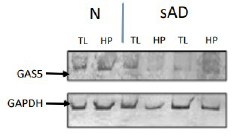Competitive Advantages
• Potential diagnosis and treatment of sporadic, late onset Alzheimer’s disease (sAD)
• Allows for early detection of AD
• Novel compound to increase lncRNA levels for in vivo sAD treatment
Summary
Using transcriptomics, scientists at USF have shown that GAS5 is significantly reduced in patients older than 65 years of age. They have further demonstrated that APP/PS1 mice, that exhibit AD pathology, showed decreased GAS5 levels in brain. GAS5 affects multiple pathways promoting the onset of sAD pathology. Thus, identifying a decrease in GAS5 may provide the opportunity to diagnose sAD at an earlier stage, potentially before other pathological symptoms occur. Furthermore, our researchers have utilized this finding to identify a small molecule that can significantly increase GAS5 levels. Once deficient GAS5 levels are identified in a patient, this therapy has the potential to serve as an early intervention for sporadic, late-onset AD, and may slow or prevent Alzheimer’s pathology.

Silver Stained PCR Gel of AD Brain Samples Showing Decreased GAS5 Levels in sAD Brain
Desired Partnerships
- License
- Sponsored Research
- Co-Development